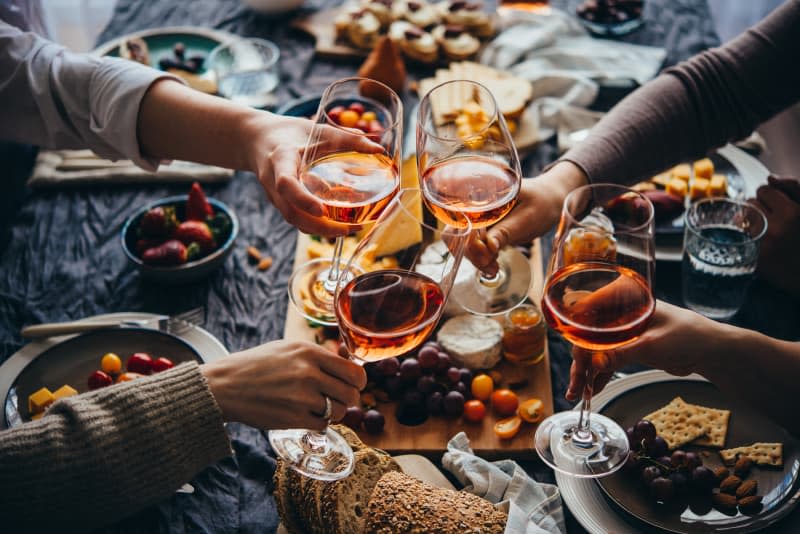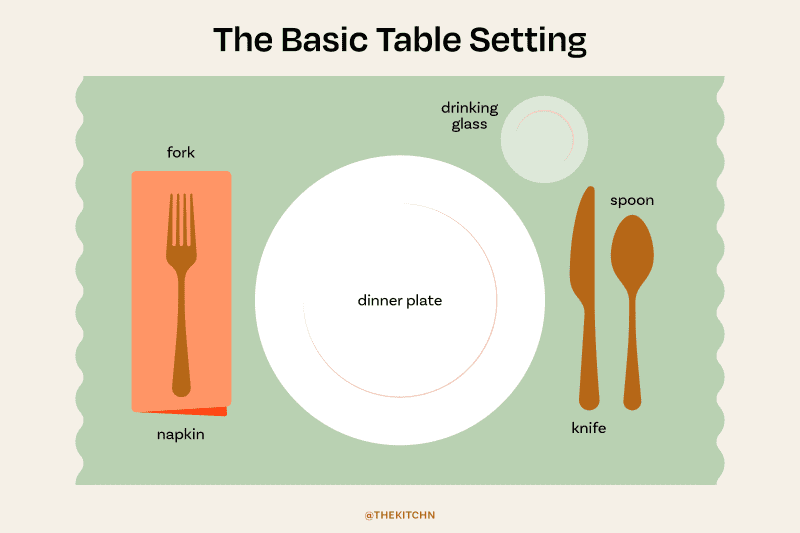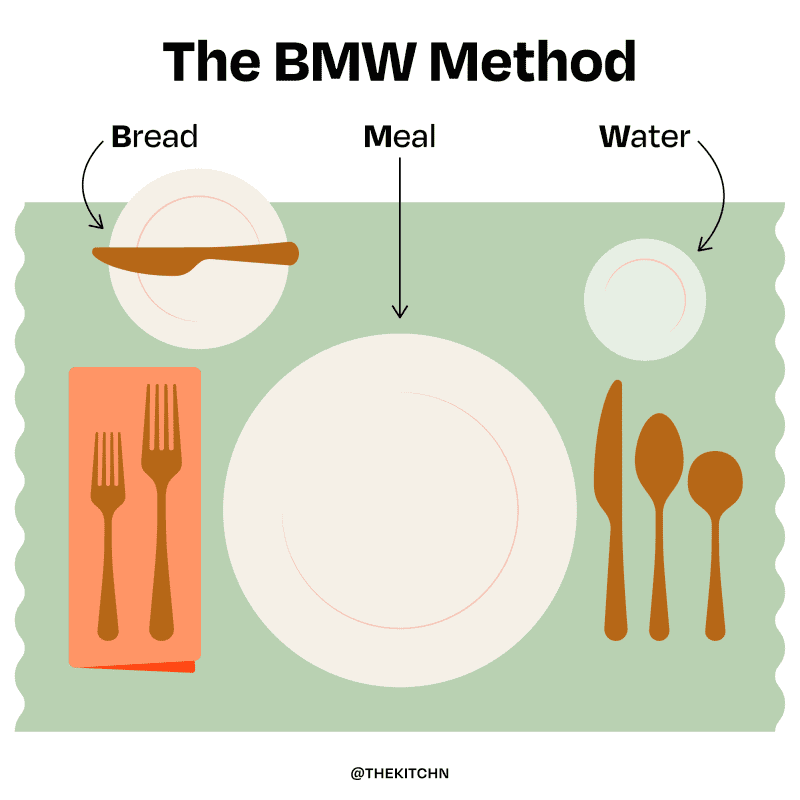The One Surprising Etiquette Rule You Didn’t Know You Were Breaking

When it comes to attending a dinner party, there’s more to know than just whether you should bring a bottle of wine for your host. Like, how do you hold your spoon? Where do you put your napkin? And, for goodness’ sake, how on earth are you supposed to eat soup without slurping or spilling? Whether or not any of these questions have ever crossed your mind, etiquette experts say there are plenty of things you need to know before attending your next function.
There are so many rules for good table manners out there, and it can feel a little overwhelming trying to nail down the best ways to act at said table. Luckily, I tapped some in-the-know etiquette experts for their top tips — read on for their best advice on what to do once that next dinner party invitation comes in, from table settings and napkins to utensils and after-meal must-dos (and don’ts!).
Table Setting Etiquette
If you’re hosting the dinner party, you want to make sure you’ve arranged and set your table correctly.
1. Only include the plates, flatware, and glasses that will be used during the meal.
For example, if you aren’t serving soup, there’s no need for soup spoons. Don’t clutter the table with items that aren’t needed.
2. Use the outside-in rule.
Align the forks, spoons, and knives along the dinner plate in the order that they will be used — with forks on the left, and knives and spoons on the right.

3. Align your table items correctly. (Learn more about basic, casual, and formal table settings here.)
Place knife blades toward the dinner plate.
Place the bread plate to the upper left of the dinner plate.
Place glassware to the upper right of the dinner plate.
Napkin Etiquette
You probably already know what napkins are used for — but there are actually a surprising amount of rules to follow with them, too. “The napkin is not a toy,” says Jules Hirst, founder and etiquette consultant at Etiquette Consulting Inc. “It is not to be crumpled into a ball or tied into knots. Its purpose is to wipe your mouth and protect your clothing from spills.”
4. Take hold of your napkin and unfold it when you sit down.
Upon sitting down, unfold the napkin and place it in your lap. “Fold it into a rectangle,” recommends Nicole Rose, founder and CEO of Poised & Proper. “The open side goes away from your body.”
5. Wait for the host in larger settings.
If you’re in someone’s home or at a hosted event, take your cues from the host. “Wait until the host places their napkin on their lap before you do the same,” says Kristi Spencer, etiquette coach and founder of The Polite Company.
6. Dab gently as needed.
Rather than sweep and swipe the napkin across your mouth, dab lightly at your lips when you need to clear away food or drink.
7. Put the napkin on your chair mid-meal.
If you need to step away from the table for any reason during the meal, place your napkin on your chair. “You can think of it as saving your seat,” says Mariah Grumet, founder of Old Soul Etiquette and author of modern wedding etiquette book What Do I Do?.
8. Remove your napkin from your lap once you’re finished.
Once you’ve finished dining and are leaving the table, loosely fold the napkin and place it to the left of your dinner plate. “Yes, it will be soiled, but so will everybody else’s,” says etiquette expert Lisa Mirza Grotts, aka Golden Rules Gal. “This non-verbally signals that the party is over.”
Utensils Etiquette
Remember those scenes in Pretty Woman and Titanic when Vivian and Jack have no idea how to use the multitudes of forks and spoons at their place settings? Holding and handling utensils correctly will place you miles ahead of your dinner party companions.
9. The dominant hand gets the main utensils.
Forks and spoons should be held in your dominant hand.
10. Knives go in the opposite hand.
“Grip the handle with your palm and secure it with your thumb and index finger,” Hirst recommends.
11. Face your fork tines correctly while cutting food.
Whenever you’re cutting food, face your fork tines down toward your plate.
12. Always go out-to-in.
As stated above, work from the outside-in while using flatware. “The first course is the outermost fork and knife, and the main course would be the inmost,” says Grotts.
13. Rest your utensils on the plate while eating.
Once you’ve used your utensils, don’t place them back on the table. Be sure to rest them on the plate.
14. Use the “continental style” or “American style.”
Did you know there are actually two different ways to rest your utensils? “Continental style is considered more refined and ideal for formal occasions, while American style is common in relaxed settings,” says Rose.
Continental style: Make an inverted “V,” placing the fork on the left with the tines facing downwards, and the knife on the right with the blade facing you.
American style: Rest both the fork and knife on the right side of the plate, placing the handles next to each other. Face the fork tines up and the knife blade toward you.
15. Put your utensils down when finished with the meal.
Rest your knife and fork parallel to each other with the handles at the edge of the plate. “Place them so that if your plate were a clock, the utensils would signify the time was 4:20,” Hirst says.
Glass Etiquette
What if there are wine glasses, water glasses, mugs, and more decorating the table? No need to worry — the pros have got your drinking covered.

16. Use the “BMW method.”
“BMW stands for bread-meal-water,” Rose says. Think about it like this — bread plate to the left, dinner plate in the middle, water glass on the right (above the knives and spoons).
17. Use the “OK method.
“Another way to figure out which drinking glass is yours? “Make an OK sign with both of your hands,” says Grumet. “Notice that your left hand makes a ‘b’ for bread and your right hand makes a ‘d’ for drink.
Dining Etiquette
So, you’ve figured out where all of your dinnerware and utensils for the meal go, and the order in which to use them. But now comes the next (best!) part of the dinner party: eating!
18. Wait in smaller groups.
For smaller groups, wait until everyone is served before you begin eating. “When you are in someone’s home, you should wait for the host to take their first bite before you take yours,” Spencer says.
19. Begin earlier in larger groups.
For larger groups or more formal occasions, take your cues from the host. If possible, wait until everyone has been served — but if the host begins, or tells you to eat while the dish is warm, you can begin once you have your meal. “Some people don’t like the attention being on them, so we want to do our best to respect their wishes,” Grumet says.
Passing Etiquette
As bowls and plates come your way during communal dining experiences, there’s a right way to make sure the next person receives them, too.
20. Pass to the right.
All dishes should go to the right. “This includes bread baskets, salt and pepper, or platters,” Grotts says. However, if someone to your left asks for a dish, you can hand it to them instead of sending it on a flight around the table.
21. Hold heavy dishes for the person next to you.
Rather than watching food spill onto the table, it’s polite to hold a heavier dish while the person next to you takes their portion.
22. Always use serving utensils.
Be sure not to use your own forks and spoons while serving.
Food Etiquette
No one wants to see food splishing, splashing, and otherwise ruining clothing or tablecloths during a meal. Here are some tips to ensure that won’t happen.
23. Keep soup from splattering.
Scoop soup away from you to keep it from splattering. “Remember to dip away, which means skimming your spoon across the top of the soup, going away from you from the front of the bowl to the back,” Spencer says. Rose also recommends sitting up straight and not slouching over your soup bowl.
24. Use the 3 Bs for bread.
Rather than buttering the entire piece of bread in one go, it’s appropriate to break off one piece of bread and butter each piece individually as you eat. “I teach students the 3 Bs of eating bread,” Spencer says. “First, break a piece of bread off the roll or slice. Then, butter the piece you broke off. Finally, take a bite.”
25. Eat spaghetti a few strands at a time.
If you only have a fork, eat spaghetti just a few strands at a time. With a spoon, you may twirl and use both utensils for those same few strands.
After-Meal Etiquette
The meal is done and you’re stuffed to the gills. Don’t forget these tips before you head out for the evening!
26. Offer to help — but respect the host’s wishes.
Yes, you proffer your table clearing services. But be sure to follow what the host tells you! “You can always offer to help clear the table,” says Grumet. “But if your host insists they do not need or want help, we want to respect their wishes.”
27. Chances are, you won’t clear your plate.
Even though that seems like the correct thing to do, it actually may be rude. “This is best left to the host or servers,” Hirst says.
28. Thank your host.
It should go without saying — but be sure to thank your host for their time and effort before walking out the door. “Thank your host and exchange pleasantries with those you were dining with,” Spencer recommends.

